Introduction
In a world increasingly driven by data, the importance of analytical reports cannot be overstated. These meticulously crafted documents transform raw data into actionable insights, guiding organizations toward informed decision-making and strategic success. By identifying trends, assessing performance, and formulating effective strategies, analytical reports serve as a critical bridge between data collection and execution.
As businesses navigate the complexities of today’s data-centric landscape, understanding the various types of analytical reports and their unique applications becomes essential. From descriptive to prescriptive reports, each type offers distinct advantages, enabling organizations to harness data’s full potential while fostering a culture of evidence-based decision-making.
This article delves into the significance of analytical reports, their key features, real-world applications, and the transformative role they play in empowering organizations to thrive in an ever-evolving market.
Understanding Analytical Reports: Definition and Purpose
Analytical summaries are carefully organized documents that refine information analysis into insights, which are types of analytical report essential for informed decision-making. Their primary objective is to transform raw information into actionable insights, which can take the form of types of analytical report that empower organizations to detect trends, assess performance, and formulate effective strategies. These documents serve as a crucial link between information gathering and strategic implementation, providing clarity and guidance to stakeholders in diverse fields, including the various types of analytical report used in business, healthcare, education, and others.
Indeed, assessment documents are essential in these sectors; they allow decisions based on empirical evidence and promote a data-oriented culture that improves overall performance. Significantly, a recent survey by PwC showed that organizations utilizing information are three times more likely to indicate substantial improvements in decision-making than those that do not prioritize types of analytical report. This statistic underscores the necessity of types of analytical report in today’s data-centric landscape.
Furthermore, it is important to recognize that while information analysis is paramount, intuition also plays a crucial role in decision-making. As psychologist Gerd Gigerenzer articulates, ‘Intuition is a form of unconscious intelligence that is as needed as conscious intelligence.’ This perspective is echoed in society, where studies show that more than half of Americans rely on their gut feelings to make decisions, even when faced with contrary evidence.
A vivid example can be seen in the case of Red Roof Inn, which adeptly identified marketing opportunities by analyzing data related to flight cancellations and adverse weather conditions near airports. Their focused campaign during adverse weather not only demonstrates the significant influence that data assessments can have on strategic choices but also emphasizes the importance of utilizing Business Intelligence (BI) and Robotic Process Automation (RPA) to optimize workflows and improve operational efficiency. As your organization navigates the overwhelming AI landscape, tailored AI solutions can empower you to cut through the noise and unlock practical information, addressing specific business challenges.
Additionally, by utilizing RPA, you can automate manual, repetitive tasks, boosting efficiency and allowing your team to focus on more strategic, value-adding work. This comprehensive approach ensures you remain competitive in the rapidly evolving market.
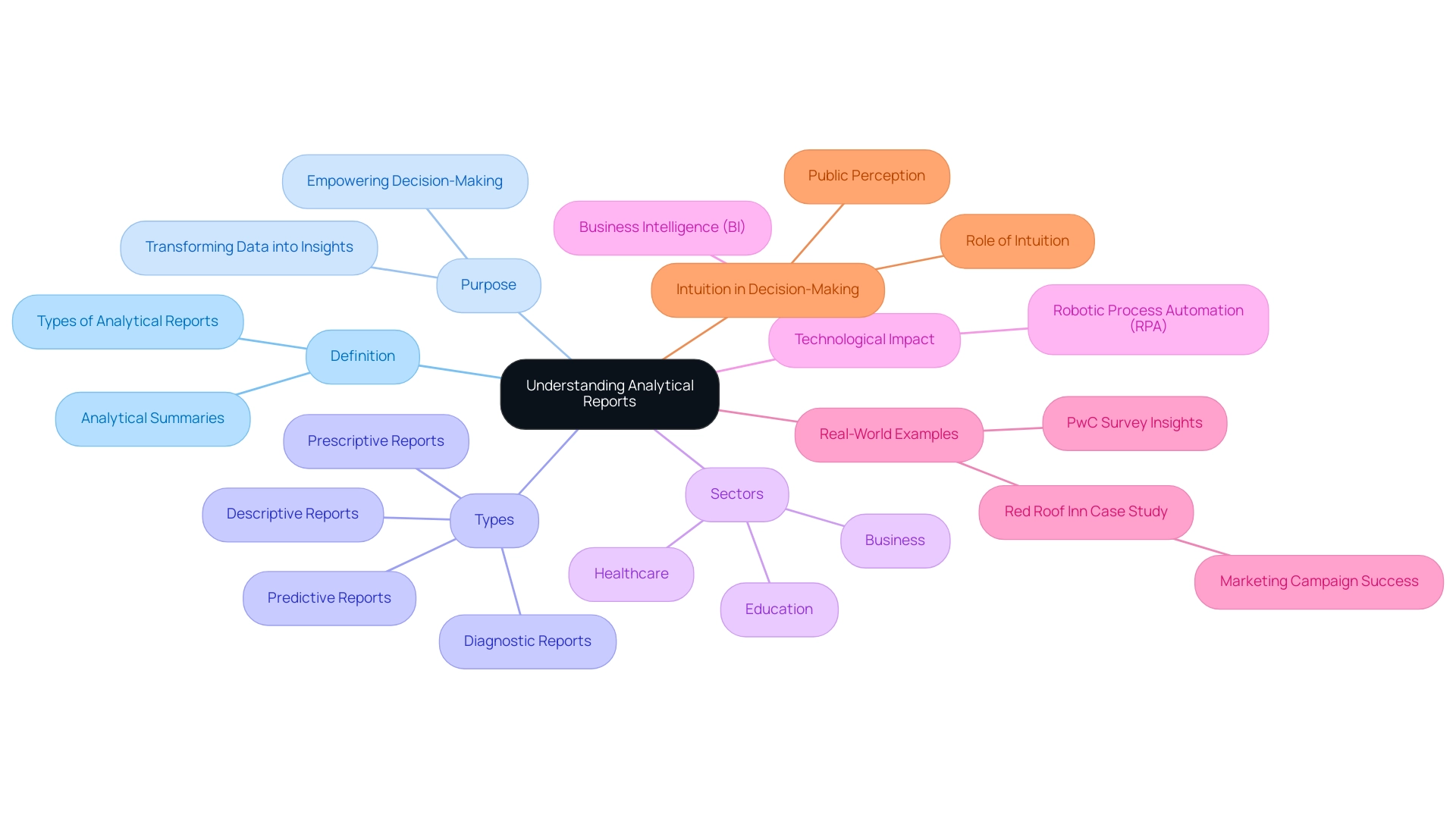
Types of Analytical Reports: A Comprehensive Breakdown
In the realm of business analytics, understanding the various types of analytical report is essential for driving operational efficiency. Every document fulfills a distinct role by offering different types of analytical report that can greatly impact decision-making.
-
Descriptive Documents: These documents offer a thorough overview of historical information, allowing organizations to understand past performance trends and results.
By reflecting on what has transpired, businesses can derive valuable insights for future strategies. -
Diagnostic Documents: Focused on revealing the underlying reasons for particular performance problems, diagnostic documents explore extensive analysis.
They highlight underlying factors that may be impacting results, facilitating targeted interventions. -
Predictive Analysis: Utilizing sophisticated statistical models and machine learning methods, predictive analysis anticipates future trends based on historical patterns.
To initiate predictive analytics, organizations must identify a problem, define what to predict, and state the desired outcomes, with information preparation being a crucial first step.
This forward-looking perspective allows organizations to anticipate changes and prepare accordingly. -
Prescriptive Documents: These documents advance analysis by not only interpreting information but also suggesting actionable strategies to enhance outcomes.
This makes them invaluable for decision-makers seeking to enhance performance and resource allocation. -
Comparative Reports: By assessing performance across various entities or time frames, comparative reports offer insights into relative effectiveness and emphasize areas ready for enhancement.
As organizations increasingly adopt cloud computing and business intelligence—54% are considering these technologies in their analytical strategies—investing in diverse reporting capabilities becomes essential.
Recent trends indicate that 56% of analytics leaders are increasing their budgets for analytics in 2023, reflecting a strong commitment to utilizing information for strategic advantage.
The integration of cloud and BI tools is transforming how businesses approach analytics, with tailored AI solutions cutting through the overwhelming options available.
Utilizing Robotic Process Automation (RPA) tools like EMMA RPA and Microsoft Power Automate can significantly enhance operational efficiency and improve employee morale.
For instance, EMMA RPA automates repetitive tasks, allowing employees to focus on more strategic initiatives, while Power Automate facilitates seamless integration across applications, streamlining workflows and reducing task repetition fatigue.
As mentioned by IBM, ‘The integration of cloud and BI tools is transforming how businesses approach analytics.’
With the demand for information analysts anticipated to increase by 30-35%, comprehending these documents and their uses is not only advantageous but crucial for operational success.
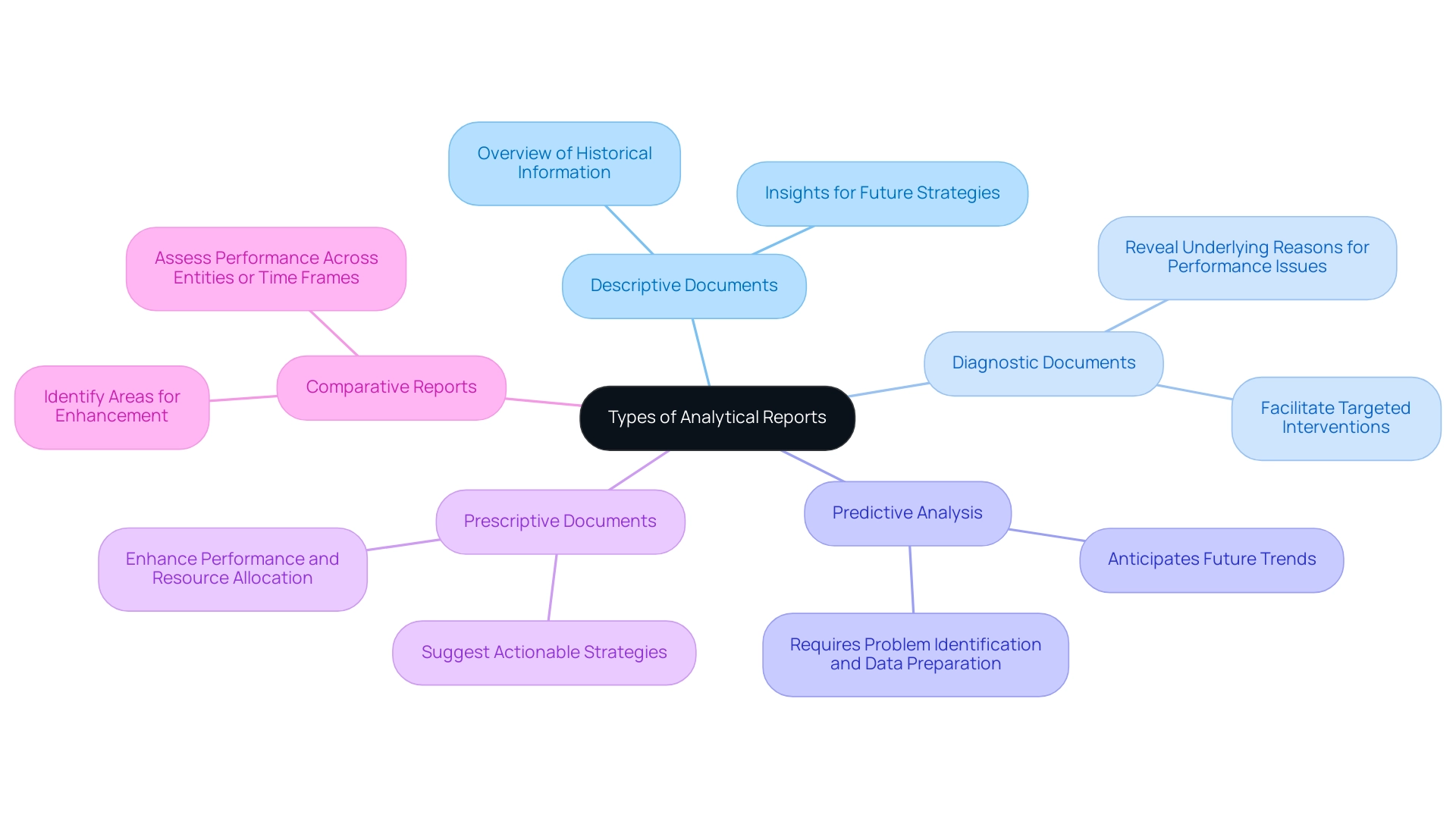
Key Features of Effective Analytical Reports
Effective analytical documents embody several essential characteristics that empower decision-makers, particularly in navigating the overwhelming AI landscape:
- Clarity: Information should be conveyed clearly and succinctly, steering clear of jargon and convoluted language to ensure comprehension. This clarity is vital as it allows businesses to navigate the multitude of AI choices and concentrate on what corresponds with their objectives, particularly by utilizing types of analytical report that meet their specific requirements.
- Relevance: The information and findings presented must directly tackle the specific queries or challenges at hand, ensuring that stakeholders can focus on what genuinely matters. Pertinent understandings from Business Intelligence can convert unprocessed information into practical strategies that promote growth and innovation, particularly when integrated with customized AI technologies, which are essential types of analytical report.
- Accuracy: Quality documents are constructed upon precise and trustworthy information sources, strengthening the validity of the conclusions reached. As mentioned by Daniel Lakens, a good approach is to interpret all statistics you present, and to trust your conclusions most when all statistical inferences provide converging support for your conclusion. This highlights the significance of a unified interpretation of data to aid well-informed decision-making.
- Visual Aids: Using graphs, charts, and tables can greatly improve comprehension and memory, rendering complex data more approachable and practical.
- Actionable Information: Ultimately, the aim of any types of analytical report is to provide information that motivates informed decision-making and strategic actions. This is especially crucial in today’s data-abundant environment, where efficient use of Business Intelligence empowers companies to achieve a competitive advantage, particularly when utilizing customized AI solutions.
An effective evaluation document also includes a submission letter that outlines its content and context, similar to a cover letter in job applications, which aids in preparing for the findings presented.
For example, in the field of Competitor Intelligence, comprehending competitors’ performance metrics—such as customer satisfaction and market share—allows clients to assess their industry position effectively. This analysis often uncovers whitespace opportunities and differentiators, amplifying the strategic value of analytical assessments. The insights derived from types of analytical report can lead to informed decisions that enhance competitive advantage.
Furthermore, with Agency Analytics able to track and showcase campaign data from more than 80 marketing platform integrations, it illustrates how varied data sources can enhance accuracy and relevance, offering a comprehensive perspective that supports customized AI solutions. Furthermore, in light of Daniel Lakens’ recent inquiry for alternative write-ups that could facilitate meta-analyses, it is crucial to ensure that documents maintain a high level of accuracy and clarity to support such comprehensive evaluations.
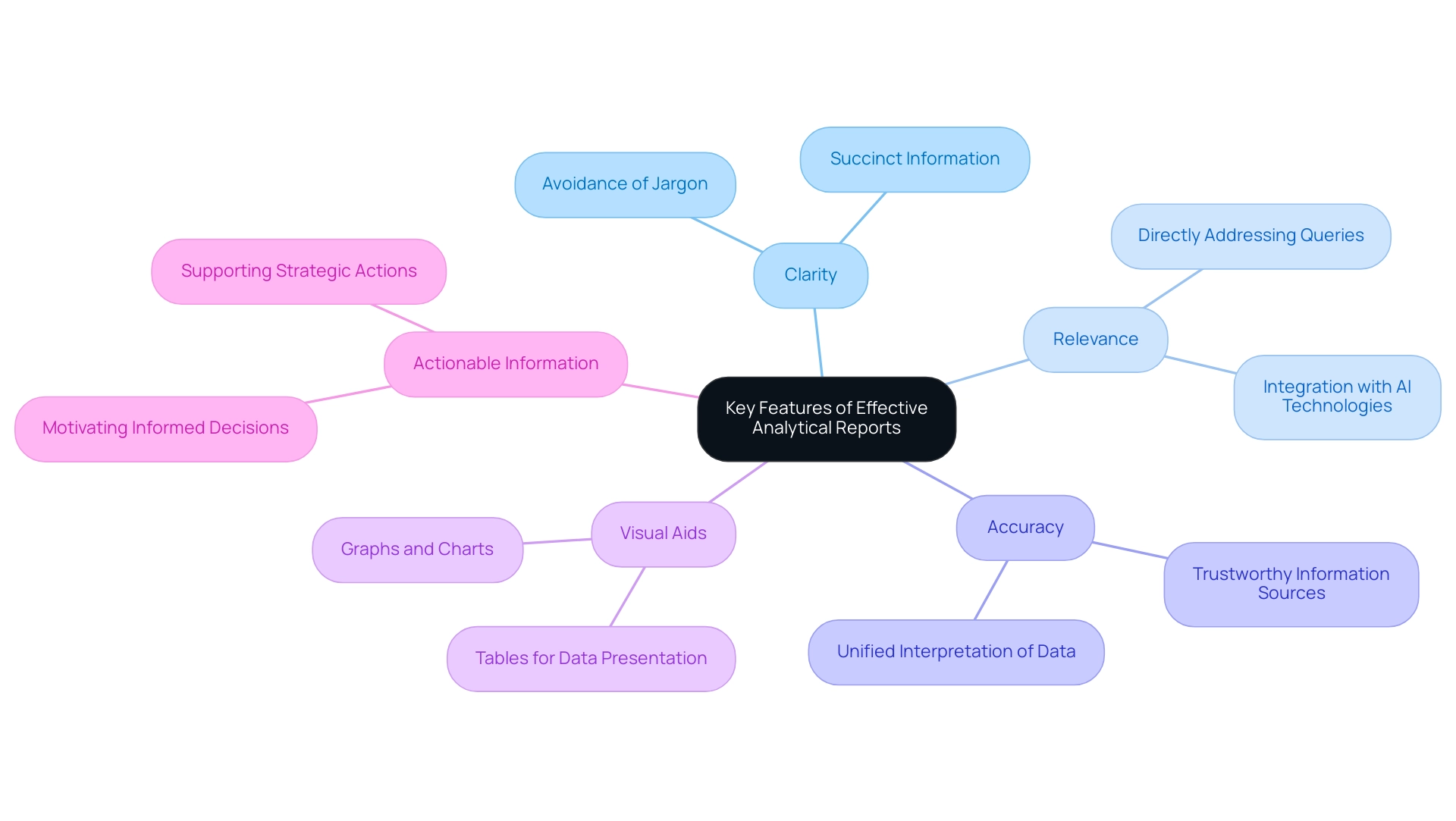
Real-World Examples of Analytical Reports
Various industries harness the power of analytical documents to enhance decision-making processes:
-
Healthcare: Hospitals utilize diagnostic analyses to evaluate patient outcomes meticulously, allowing them to pinpoint areas needing improvement in care delivery. The systematic literature review encompassing healthcare information from 2011 to 2021 emphasizes the crucial role of types of analytical report in promoting progress in clinical practices. For example, a sensor-equipped robot design for diagnosing Parkinson’s disease has been created, incorporating sensors within the patient’s body to gather information for analysis, significantly enhancing diagnostic capabilities. Additionally, by implementing GUI automation to streamline data entry and software testing, healthcare providers have reduced data entry errors by 70% and improved workflow efficiency by 80%, demonstrating a clear path to enhanced operational efficiency. This implementation involved utilizing RPA to automate repetitive tasks, thus freeing up staff to focus on higher-value activities, which is critical in a sector where time and accuracy are paramount.
-
Finance: In the finance sector, investment firms utilize various types of analytical reports that rely on predictive analyses to anticipate market trends, providing a foundation for strategic investment decisions. As Alshymaa Alghamdi from Umm Al-Qura University states, predictive analytics answers the critical question: ‘What happened?’ thereby facilitating informed decision-making. This highlights the significance of grasping historical occurrences to direct future strategies.
-
Retail: Retail giants like Amazon utilize different types of analytical reports to evaluate sales performance across diverse regions, optimizing inventory management and enhancing customer satisfaction. These evaluative observations enable businesses to make data-informed choices that directly influence their profitability.
-
Manufacturing: Types of analytical report are crucial in manufacturing for monitoring production metrics. By identifying inefficiencies in their processes, organizations can implement targeted strategies to streamline operations and increase productivity. Such applications of analytics are crucial for maintaining competitiveness in a rapidly evolving market.
By leveraging these analytical frameworks alongside RPA, industries not only improve their operational efficiencies but also set a strong foundation for future growth and innovation. The integration of RPA into manual workflows addresses challenges such as human error and process delays, ultimately leading to a more agile and responsive business model.
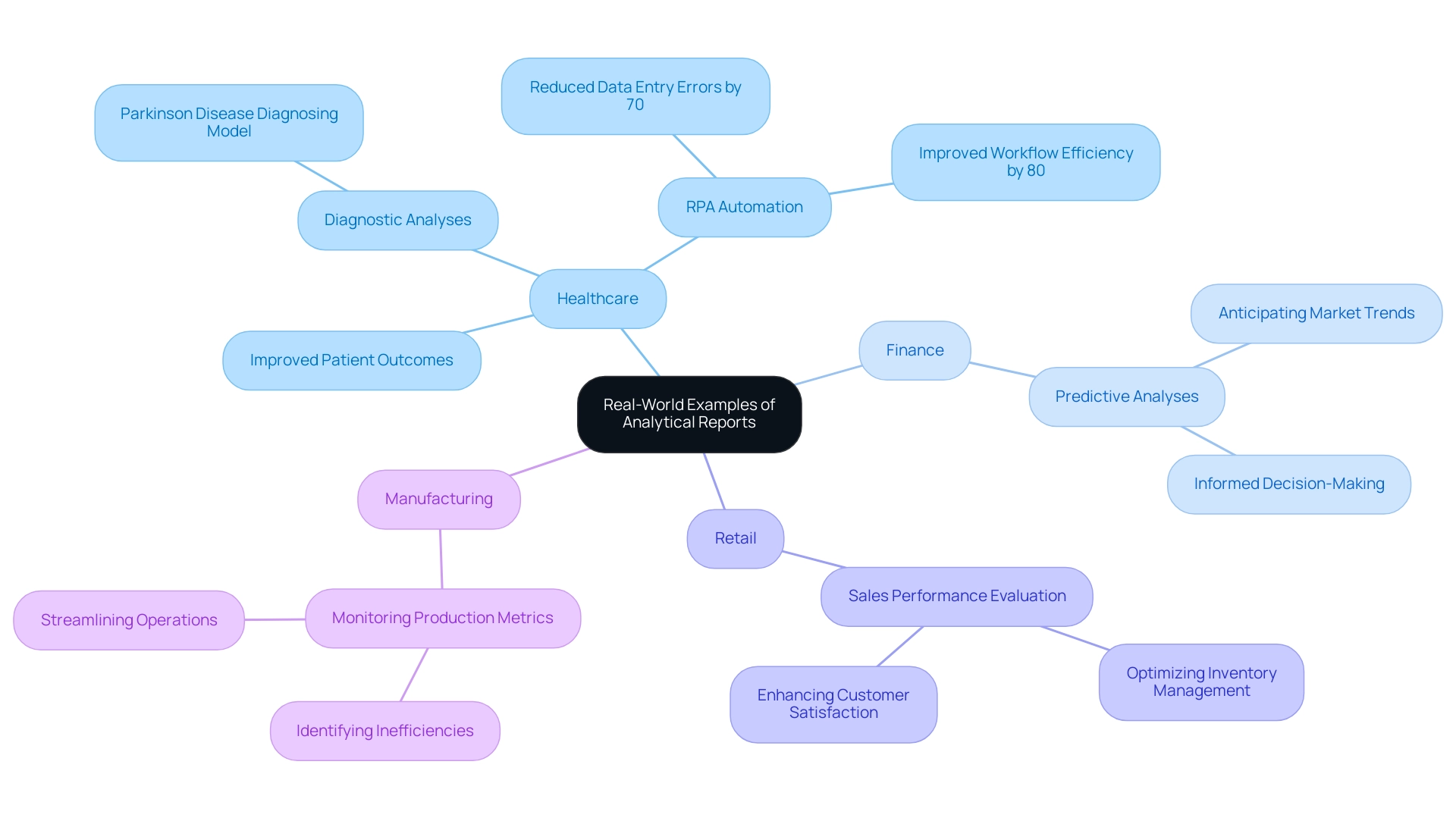
The Role of Analytical Reports in Informed Decision-Making
Types of analytical report serve as a cornerstone of informed decision-making, equipping organizations with essential data-driven knowledge that guides strategic initiatives. They enable companies to identify their strengths and weaknesses, gauge market conditions, and reflect on the repercussions of previous actions. For instance, the 3-Day Power BI Sprint enables organizations to create a fully functional, professionally designed document on a topic of their choice quickly.
This not only enables teams to focus on leveraging insights rather than getting bogged down in document creation but also provides a template for future projects, ensuring a professional design from the start. A recent study highlights that a staggering 82% of breaches stem from human error, underscoring the critical need for employee education on privacy best practices to mitigate these risks. By integrating types of analytical report into their decision-making structures, organizations can reduce uncertainty, enhance accountability, and foster a culture of continuous improvement.
According to Catherine Cote from MicroStrategy, 56 percent of respondents stated that analytics resulted in ‘faster, more effective decision-making’ at their companies. This capability empowers leaders to make choices that resonate with their business objectives and enhance operational efficiency, ultimately driving better outcomes in a competitive landscape. Additionally, leveraging Robotic Process Automation (RPA) allows businesses to automate manual workflows, freeing up teams for more strategic tasks.
The integration of advanced technologies like AI and machine learning is revolutionizing this domain, as evidenced by the case study on AI and Machine Learning in Data Analysis, where these technologies automate repetitive tasks and allow analysts to concentrate on strategic decision-making. This not only amplifies the effectiveness of data analysis but also illustrates how organizations can leverage different types of analytical reports to improve decisions and outcomes.
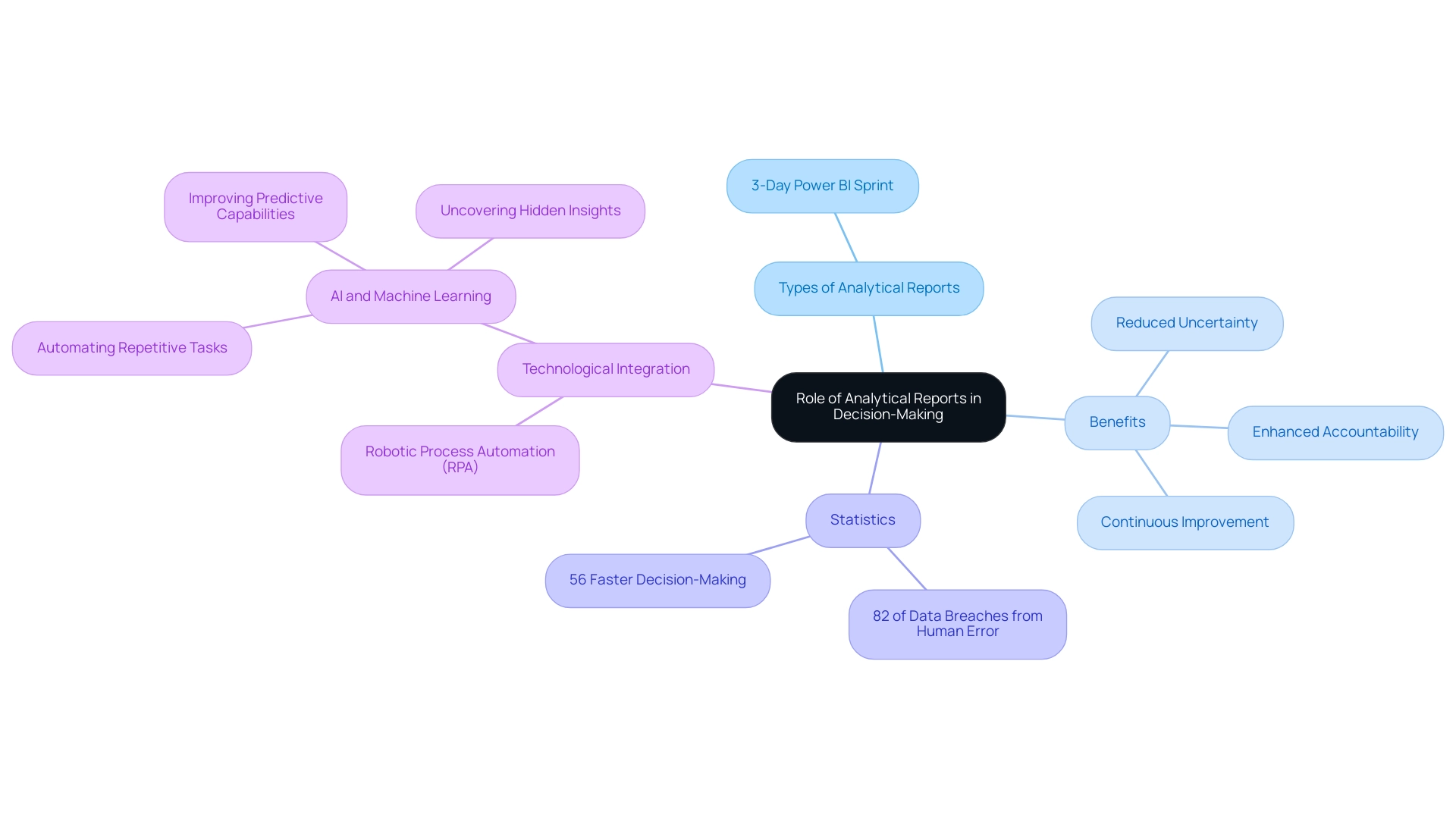
Conclusion
Analytical reports are not just valuable tools; they are essential for organizations aiming to thrive in a data-driven landscape. By transforming raw data into actionable insights, these reports empower decision-makers to identify trends, assess performance, and formulate effective strategies. Understanding the various types of analytical reports—descriptive, diagnostic, predictive, prescriptive, and comparative—provides organizations with the ability to tailor their approach to specific challenges, ensuring the most impactful outcomes.
The key features of effective analytical reports—clarity, relevance, accuracy, visual aids, and actionable insights—serve as the foundation for informed decision-making. By leveraging these characteristics, organizations can cut through the complexities of data and focus on what truly matters. Real-world applications across industries such as healthcare, finance, retail, and manufacturing illustrate the transformative power of analytical reports in driving operational efficiency and strategic growth.
As organizations increasingly embrace advanced technologies like Robotic Process Automation and artificial intelligence, the role of analytical reports becomes even more pronounced. These reports not only enhance decision-making processes but also foster a culture of data-driven innovation. Embracing analytical reporting is crucial for organizations aiming to navigate the complexities of today’s market, ensuring they remain competitive and poised for success. By prioritizing these insights, organizations can effectively harness their data to drive better outcomes and achieve their strategic goals.

